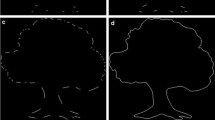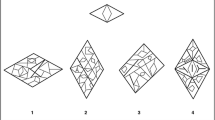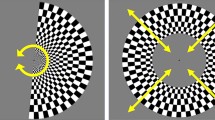Abstract
Earlier work examining susceptibility to visual illusions in autism has reported discrepant findings. Some of this research suggests that global processing is affected in autism while some of this research suggests otherwise. The discrepancies may relate to compliance issues and differences in population samples in terms of symptom severity, cognitive ability, and co-morbid disorders. Equally important, most of this work tended to treat global processing as if it were a singular construct, invoking similar cognitive operations across different visual illusions. We argue that this is not a fair assumption to make given the extensive research that has classified visual illusions on the basis of their cognitive demands. With this in mind, and to overcome the many caveats associated with examining a heterogeneous disorder such as autism directly, we examined how susceptibility to various illusions relates differently to people’s scores on the Autism Spectrum Quotient (AQ) questionnaire. We found that susceptibility to the Müller-Lyer but not to the Ebbinghaus and Ponzo illusions decreased as a function of AQ and that the relationship between AQ and susceptibility to the Müller-Lyer illusion was different from those between AQ and susceptibility to the Ebbinghaus and Ponzo illusions. Our findings confirm that the cognitive operations underlying global processing in the Müller-Lyer illusion are different from the other illusions and, more importantly, reveal that they might be affected in autism. Future brain mapping studies could provide additional insight into the neural underpinnings of how global processing might and might not be affected in autism.




Similar content being viewed by others
References
Association AP (2000) Diagnostic and statistical manual of mental disorders. American Psychiatric Association, Washington, DC
Austin EJ (2005) Personality correlates of the broader autism phenotype as assessed by the Autism Spectrum Quotient (AQ). Pers Individ Dif 38:451–460
Bar M (2004) Visual objects in context. Nat Rev Neurosci 5:617–629
Baron-Cohen S, Wheelwright S, Hill J, Raste Y, Plumb I (2001a) The “reading the mind in the eyes” test revised version: a study with normal adults, and adults with Asperger syndrome or high-functioning autism. J Child Psychol Psychiatry 42:241–251
Baron-Cohen S, Wheelwright S, Skinner R, Martin J, Clubley E (2001b) The autism-spectrum quotient (AQ): evidence from Asperger syndrome/high-functioning autism, males and females, scientists and mathematicians. J Autism Dev Disord 31:5–17
Bayliss AP, Kritikos A (2011) Brief report: perceptual load and the autism spectrum in typically developed individuals. J Autism Dev Disord 41:1573–1578
Bayliss AP, Tipper SP (2005) Gaze and arrow cueing of attention reveals individual differences along the autism spectrum as a function of target context. Br J Psychol 96:95–114
Ben-Shalom A, Ganel T (2012) Object representations in visual memory: evidence from visual illusions. J Vis 12:1–11
Bölte S, Holtmann M, Poustka F, Scheurich A, Schmidt L (2007) Gestalt perception and local-global processing in high-functioning autism. J Autism Dev Disord 37:1493–1504
Buckingham G, Goodale MA (2013) Size matters: a single representation underlies our perceptions of heaviness in the size-weight illusion. PLoS ONE 8:e54709
Catani M, Ffytche DH (2005) The rises and falls of disconnection syndromes. Brain 128:2224–2239
Centers for Disease Control and Prevention (2012) Prevalence of autism spectrum disorders- autism and developmental disabilities monitoring network, United States, 2008. Morb Mortal Wkly Rep 61:1–24
Coren S, Enns JT (1993) Size contrast as a function of conceptual similarity between test and inducers. Percept Psychophys 54:579–588
Coren S, Girgus JS, Erlichman H, Hakstian AR (1976) An empirical taxonomy of visual illusions. Percept Psychophys 20:129–137
Donohue SE, Darling EF, Mitroff SR (2012) Links between multisensory processing and autism. Exp Brain Res 222:377–387
Dunn OJ (1961) Multiple comparisons among means. J Am Stat Assoc 56:52–64
Fang F, Boyaci H, Kersten D, Murray SO (2008) Attention-dependent representation of a size illusion in human V1. Curr Biol 18:1707–1712
Farah MJ (2004) Visual agnosia. MIT Press, Cambridge, MA
Frith U (1989) Autism: explaining the enigma. Blackwell Scientific Publications, Oxford
Gillberg C, Billstedt E (2000) Autism and Asperger syndrome: coexistence with other clinical disorders. Acta Psychiatr Scand 102:321–330
Ginsburg AP (1984) Visual form perception based on biological filtering. In: Spillman L, Wooten BR (eds) Sensory experience, adaptation and perception. Erlbaum, Hillsdale, NJ
Gregory RL (1963) Distortion of visual space as inappropriate constancy scaling. Nature 199:678–680
Gregory RL (2009) Seeing through illusions. Oxford University Press, Oxford
Happé FG (1996) Studying weak central coherence at low levels: children with autism do not succumb to visual illusions. A research note. J Child Psychol Psychiatry 37:873–877
Happé F (1999) Autism: cognitive deficit or cognitive style? Trends Cogn Sci 3:216–222
Happé F, Frith U (2006) The weak coherence account: detail-focused cognitive style in autism spectrum disorders. J Autism Dev Disord 36:5–25
Happé F, Ronald A, Plomin R (2006) Time to give up on a single explanation for autism. Nat Neurosci 9:1218–1220
Howe CQ, Purves D (2005) The Muller-Lyer illusion explained by the statistics of image-source relationships. Proc Natl Acad Sci USA 102:1234–1239
Hoy JA, Hatton C, Hare D (2004) Weak central coherence: a cross-domain phenomenon specific to autism? Autism 8:267–281
Hudson M, Nijboer TC, Jellema T (2012) Implicit social learning in relation to autistic-like traits. J Autism Dev Disord 42:2534–2545
Jolliffe T, Baron-Cohen S (1997) Are people with autism and Asperger syndrome faster than normal on the Embedded Figures Test? J Child Psychol Psychiatry 38:527–534
Maes JH, Vissers CT, Egger JI, Eling PA (2013) On the relationship between autistic traits and executive functioning in a non-clinical Dutch student population. Autism 17:379–389
McCready DW Jr (1965) Size-distance perception and accommodation-convergence micropsia—a critique. Vis Res 5:189–206
McCready D (1985) On size, distance, and visual angle perception. Percept Psychophys 37:323–334
Milne E, Swettenham J, Hansen P, Campbell R, Jeffries H, Plaisted K (2002) High motion coherence thresholds in children with autism. J Child Psychol Psychiatry 43:255–263
Mottron L, Burack JA (2001) Enhanced perceptual functioning in the development of autism. In: Burack JA, Charman T, Yirmiya N, Zelazo PR (eds) The development of autism: Perspectives from theory and research. Erlbaum, Mahwah, NJ
Mottron L, Dawson M, Soulieres I, Hubert B, Burack J (2006) Enhanced perceptual functioning in autism: an update, and eight principles of autistic perception. J Autism Dev Disord 36:27–43
Murray SO, Boyaci H, Kersten D (2006) The representation of perceived angular size in human primary visual cortex. Nat Neurosci 9:429–434
Plewan T, Weidner R, Eickhoff SB, Fink GR (2012) Ventral and dorsal stream interactions during the perception of the Muller-Lyer illusion: evidence derived from fmri and dynamic causal modeling. J Cogn Neurosci 24:2015–2029
Pressey AW (1967) A theory of the Mueller-Lyer illusion. Percept Mot Skills 25:569–572
Pressey AW, Epp D (1992) Spatial attention in Ponzo-like patterns. Percept Psychophys 52:211–221
Prinzmetal W, Shimamura AP, Mikolinski M (2001) The Ponzo illusion and the perception of orientation. Percept Psychophys 63:99–114
Ropar D, Mitchell P (1999) Are individuals with autism and Asperger’s syndrome susceptible to visual illusions? J Child Psychol Psychiatry 40:1283–1293
Ropar D, Mitchell P (2001) Susceptibility to illusions and performance on visuospatial tasks in individuals with autism. J Child Psychol Psychiatry 42:539–549
Schwarzkopf DS, Song C, Rees G (2011) The surface area of human V1 predicts the subjective experience of object size. Nat Neurosci 14:28–30
Segall MH, Campbell DT, Herskovits MJ (1963) Cultural differences in the perception of geometric illusions. Science 139:769–771
Shah A, Frith U (1983) An islet of ability in autistic children: a research note. J Child Psychol Psychiatry 24:613–620
Spencer J, O’Brien J, Riggs K, Braddick O, Atkinson J, Wattam-Bell J (2000) Motion processing in autism: evidence for a dorsal stream deficiency. Neuroreport 11:2765–2767
Sperandio I, Savazzi S, Marzi CA (2010) Is simple reaction time affected by visual illusions? Exp Brain Res 201:345–350
Sperandio I, Chouinard PA, Goodale MA (2012) Retinotopic activity in V1 reflects the perceived and not the retinal size of an afterimage. Nat Neurosci 15:540–542
Sutherland A, Crewther DP (2010) Magnocellular visual evoked potential delay with high autism spectrum quotient yields a neural mechanism for altered perception. Brain 133:2089–2097
Walter E, Dassonville P, Bochsler TM (2009) A specific autistic trait that modulates visuospatial illusion susceptibility. J Autism Dev Disord 39:339–349
Weidner R, Fink GR (2007) The neural mechanisms underlying the Muller-Lyer illusion and its interaction with visuospatial judgments. Cereb Cortex 17:878–884
Whitehouse AJ, Barry JG, Bishop DV (2007) The broader language phenotype of autism: a comparison with specific language impairment. J Child Psychol Psychiatry 48:822–830
Acknowledgments
This work was supported by postdoctoral fellowship awards from the Ontario Mental Health Foundation to P.A.C and from the Ontario Ministry of Research and Innovation to I.S.
Author information
Authors and Affiliations
Corresponding author
Rights and permissions
About this article
Cite this article
Chouinard, P.A., Noulty, W.A., Sperandio, I. et al. Global processing during the Müller-Lyer illusion is distinctively affected by the degree of autistic traits in the typical population. Exp Brain Res 230, 219–231 (2013). https://doi.org/10.1007/s00221-013-3646-6
Received:
Accepted:
Published:
Issue Date:
DOI: https://doi.org/10.1007/s00221-013-3646-6




